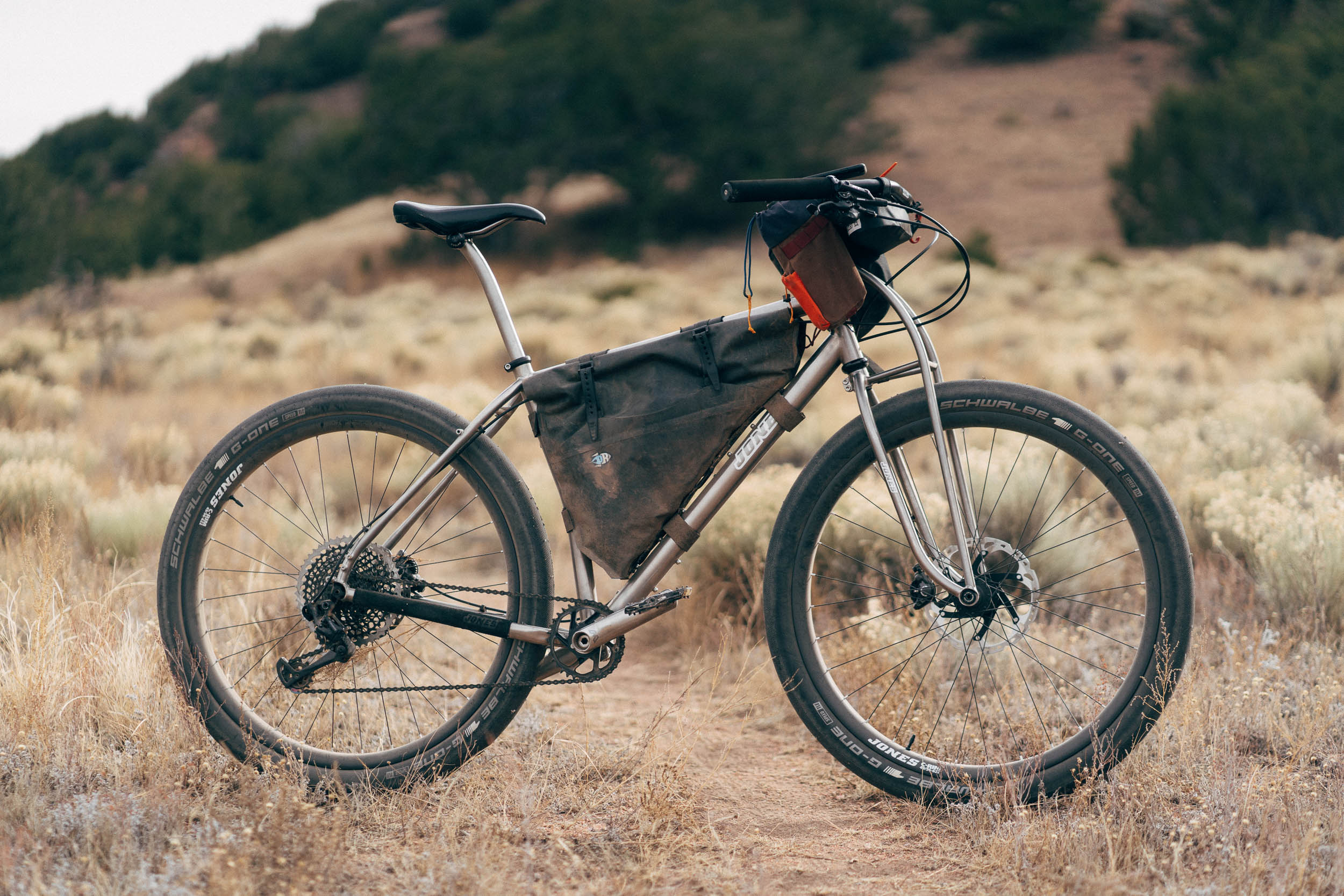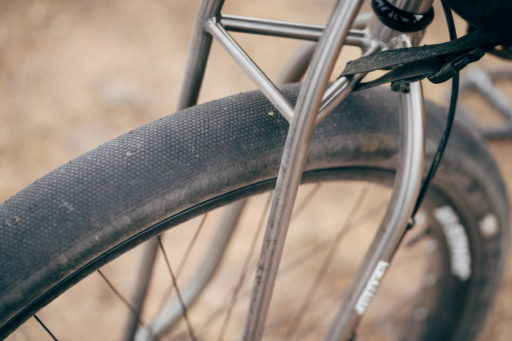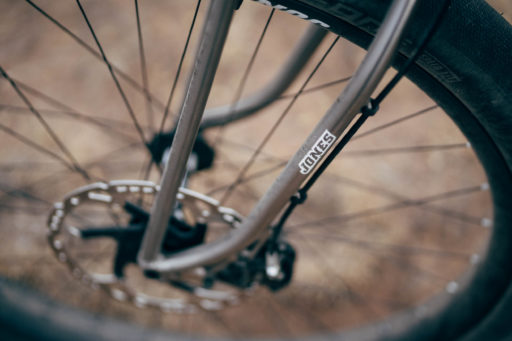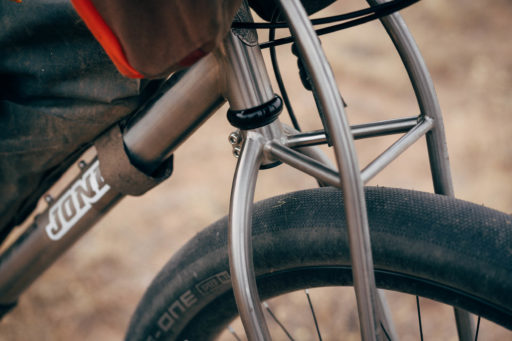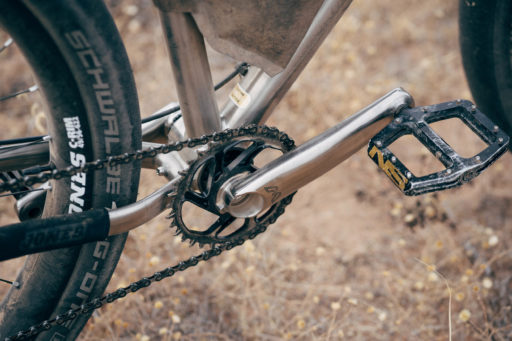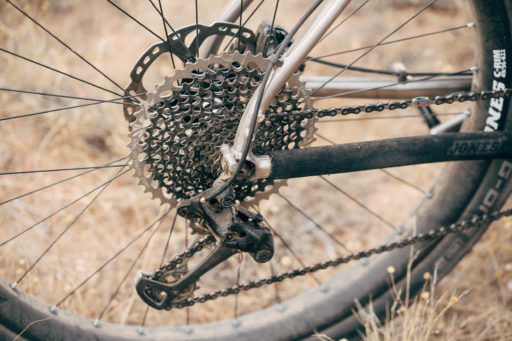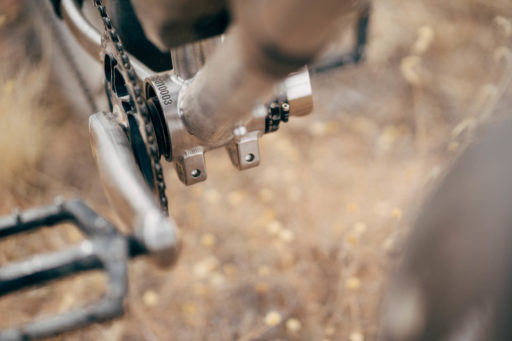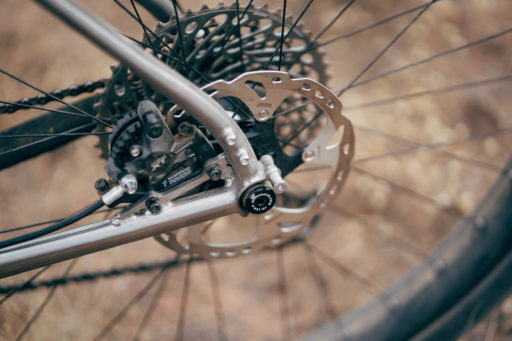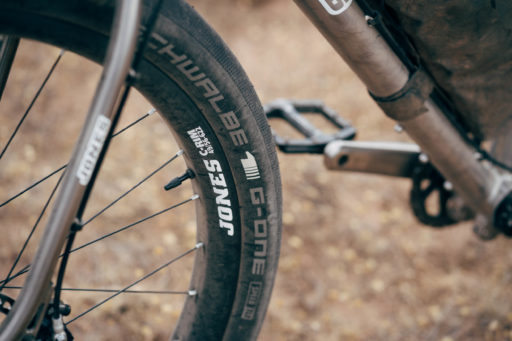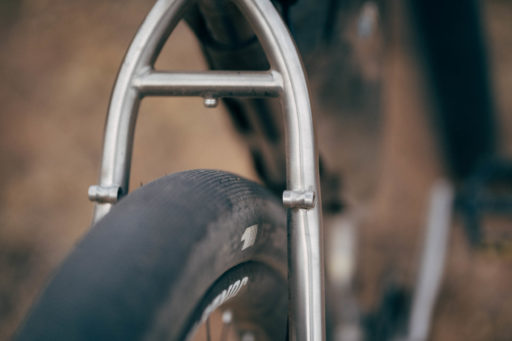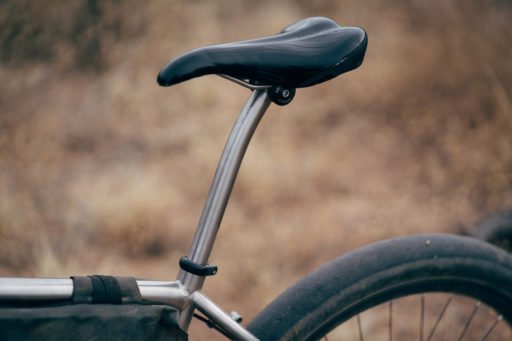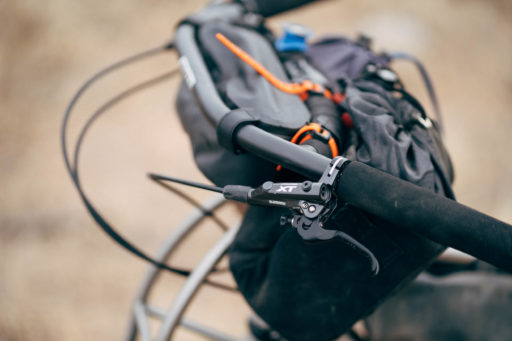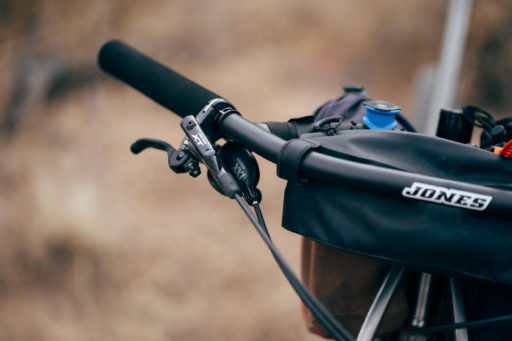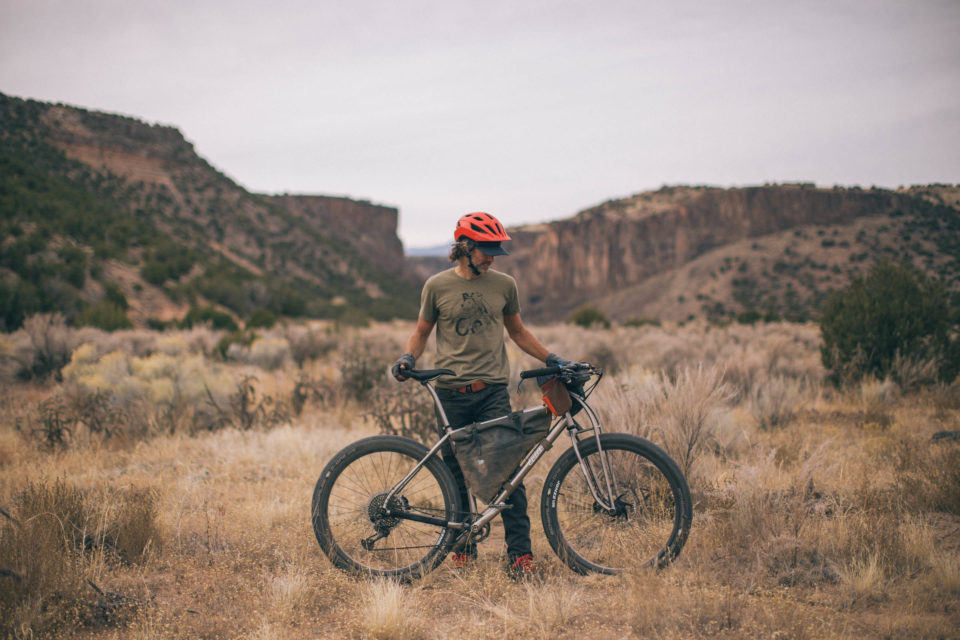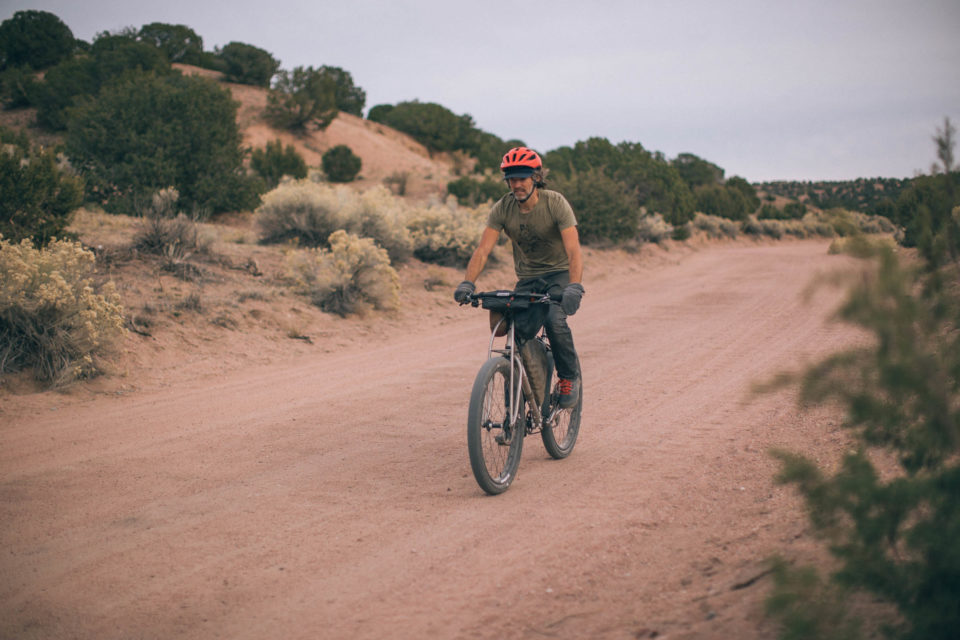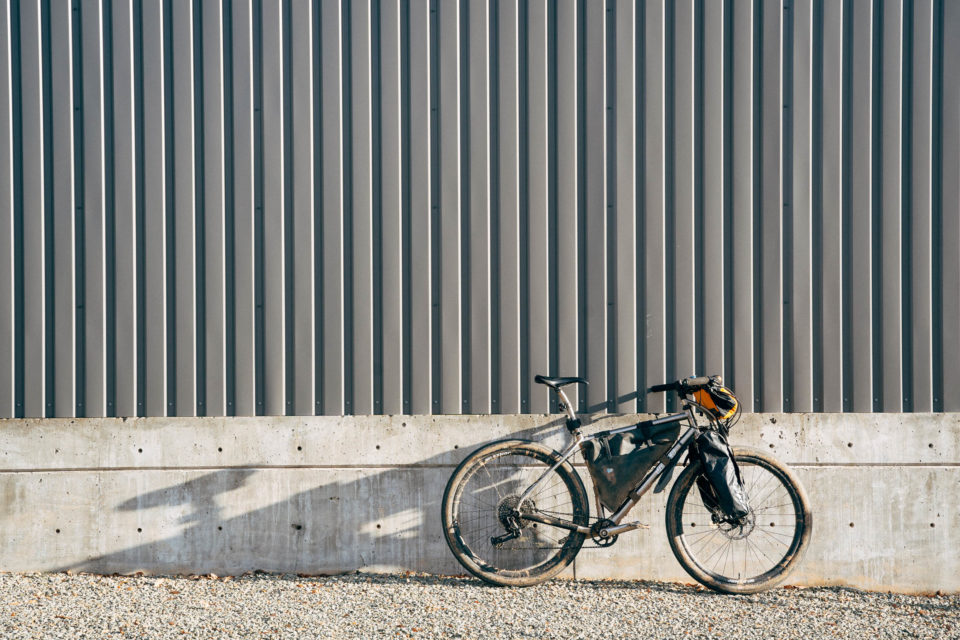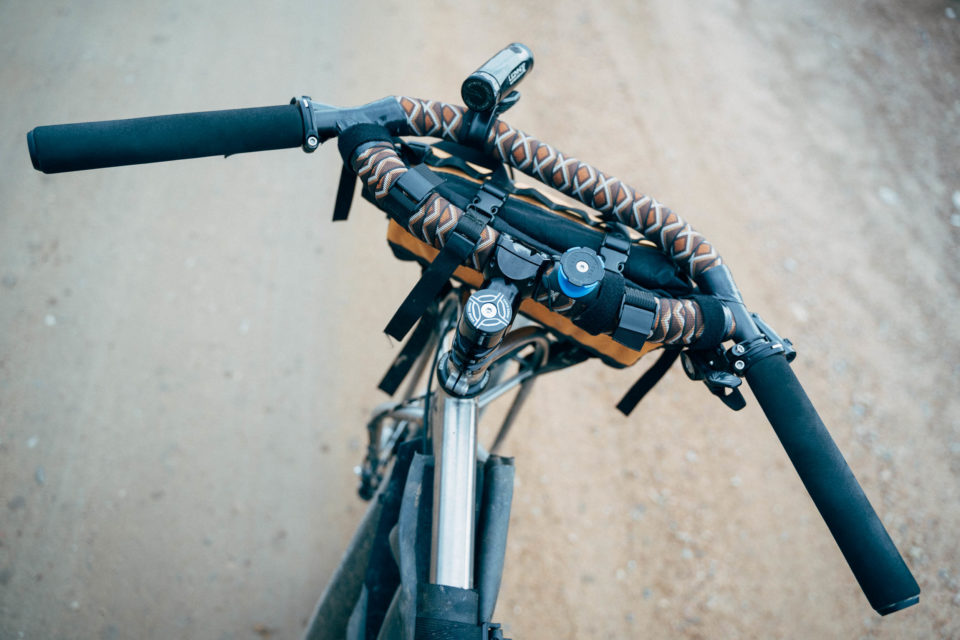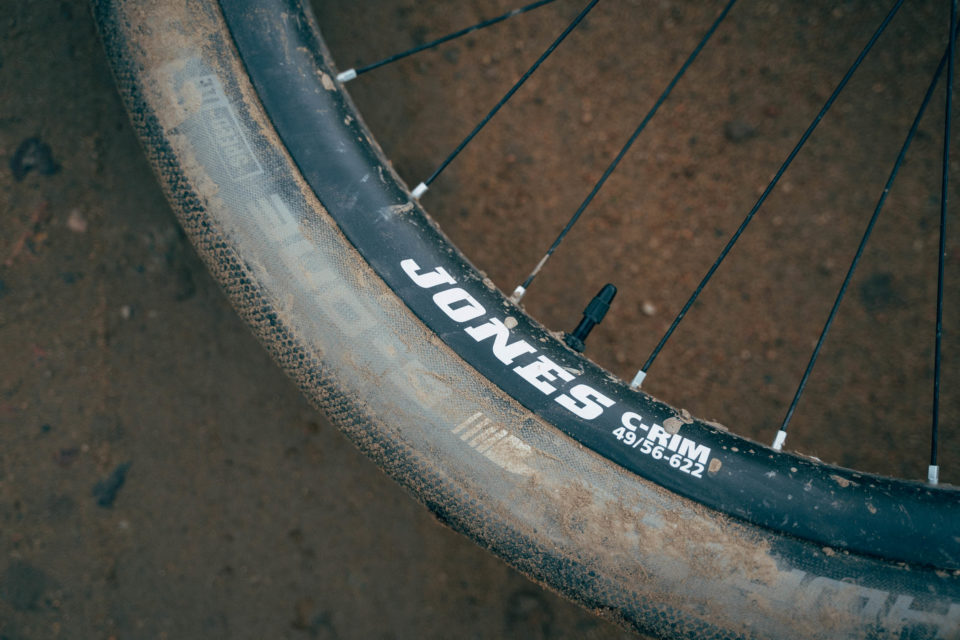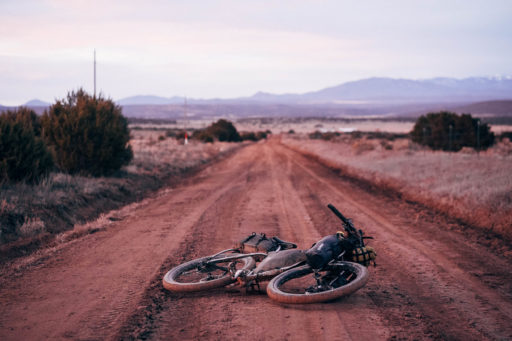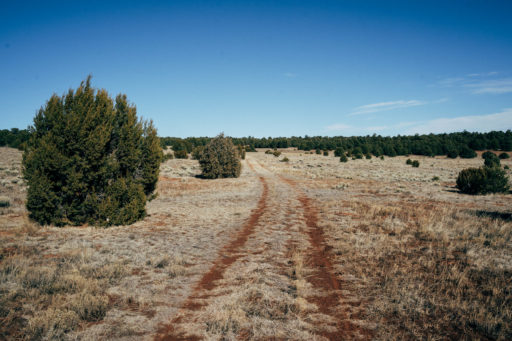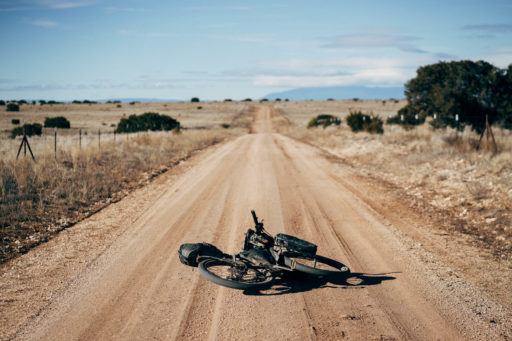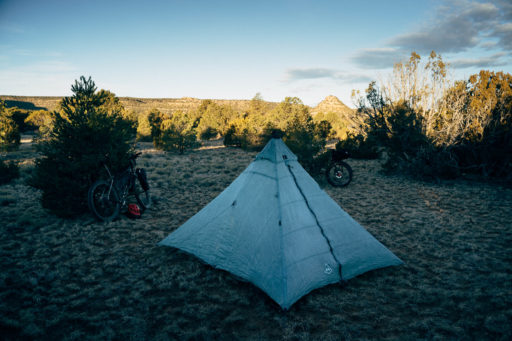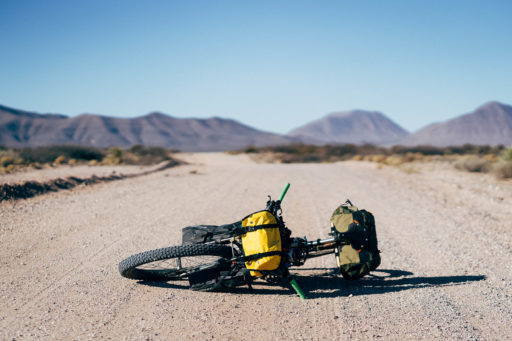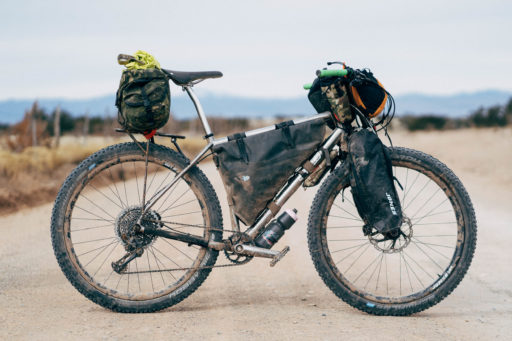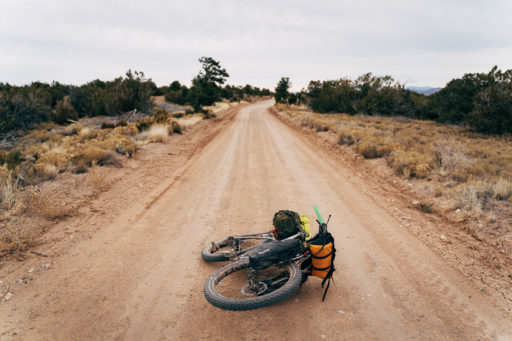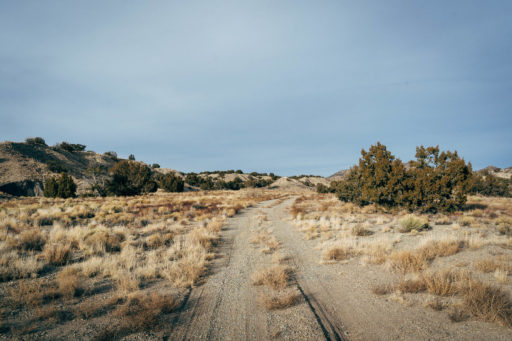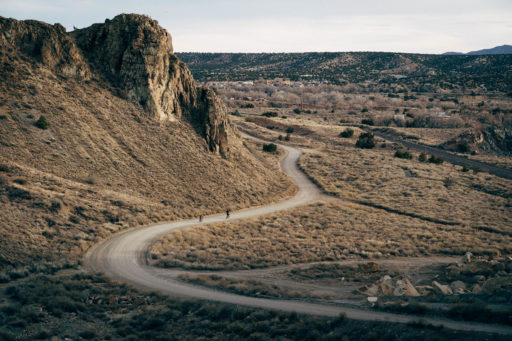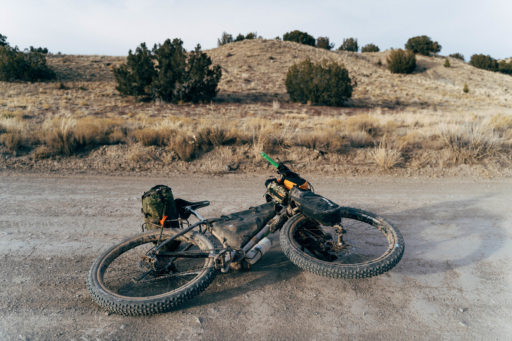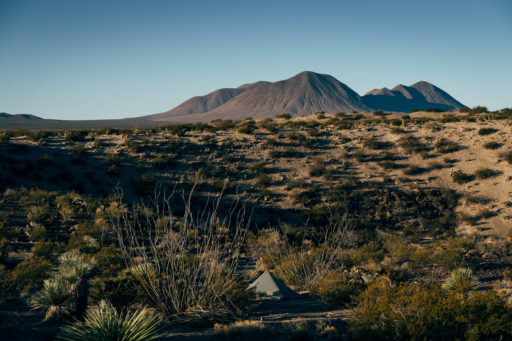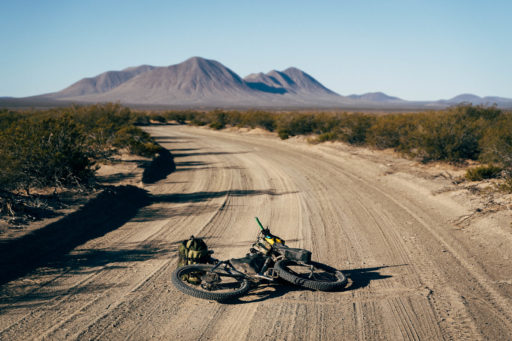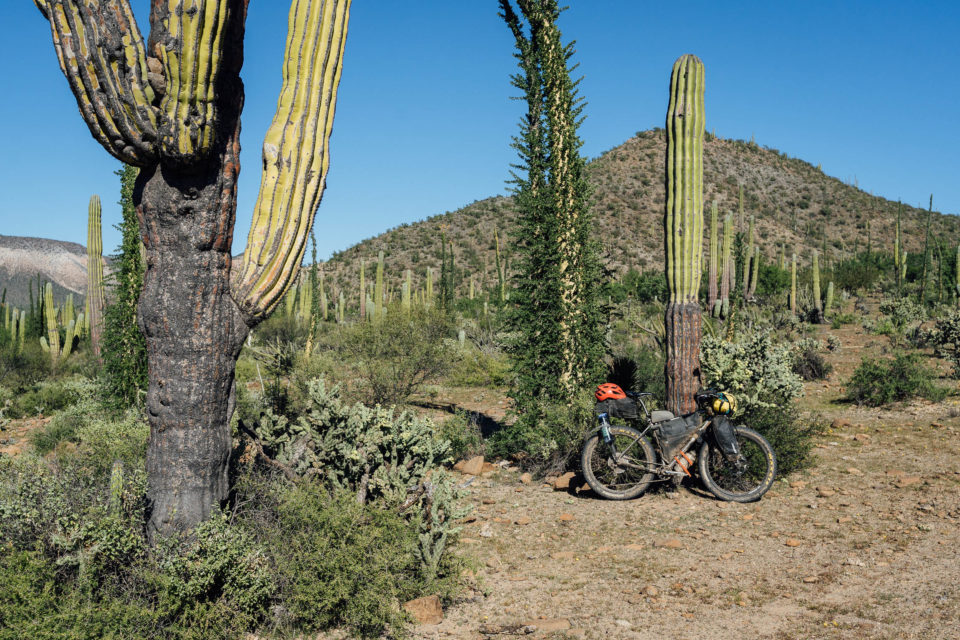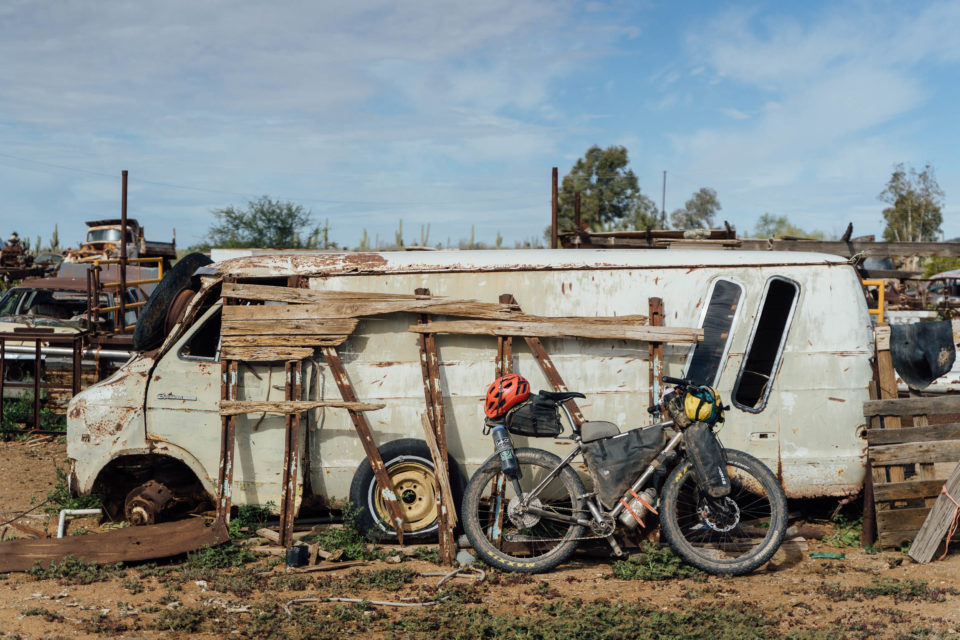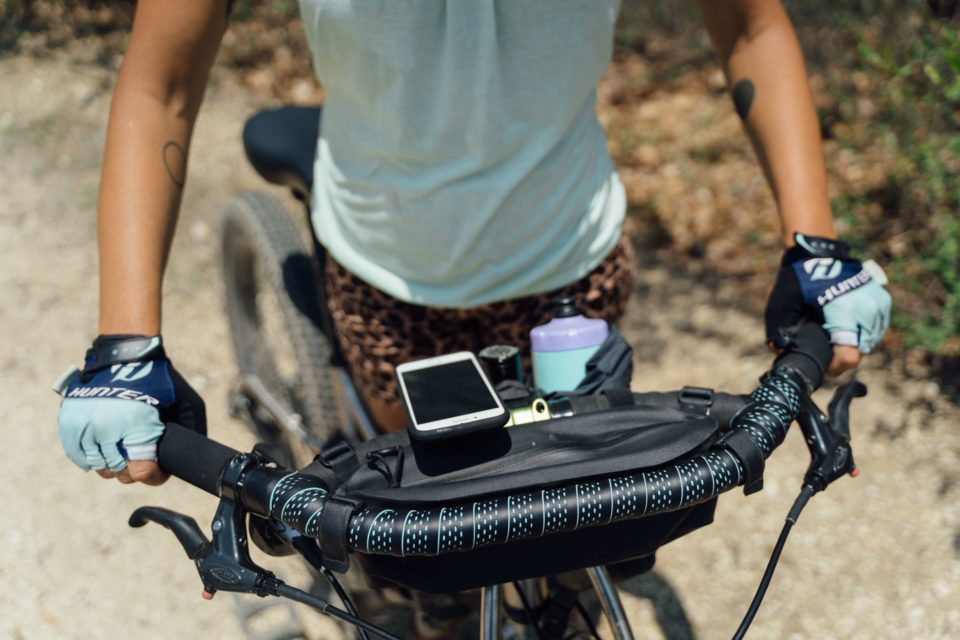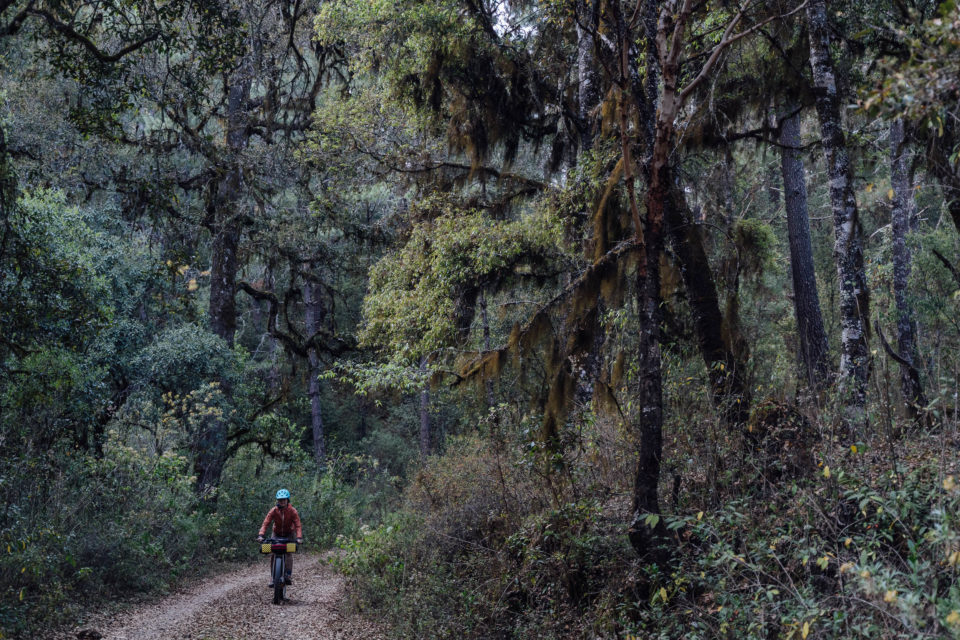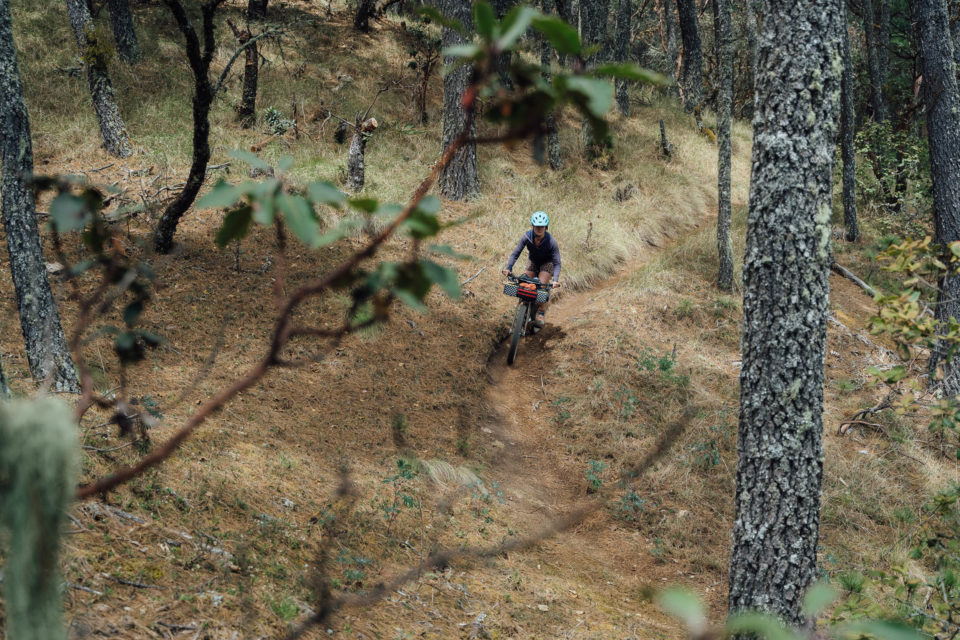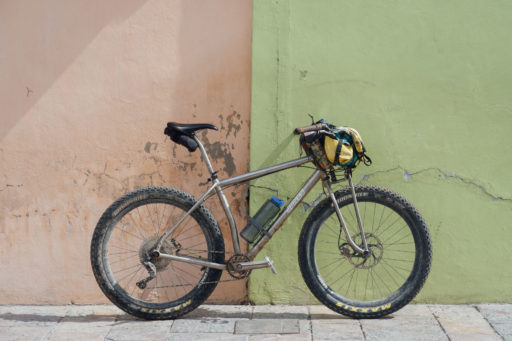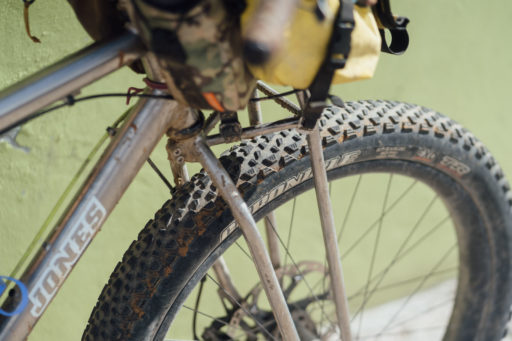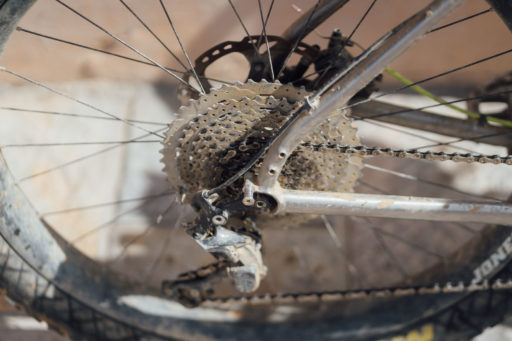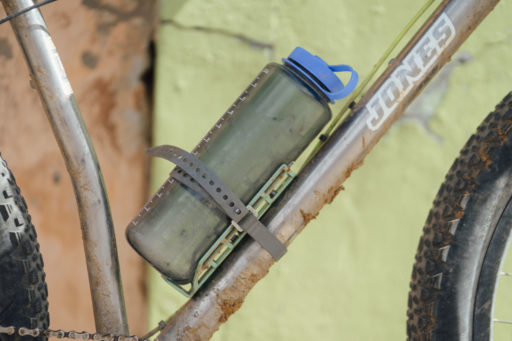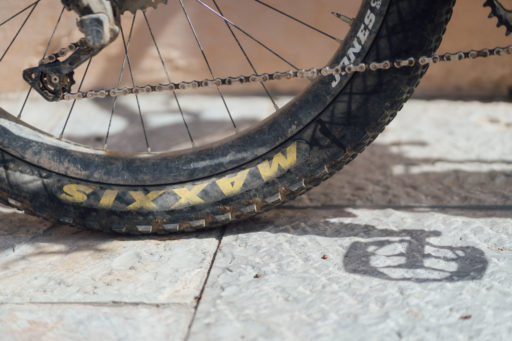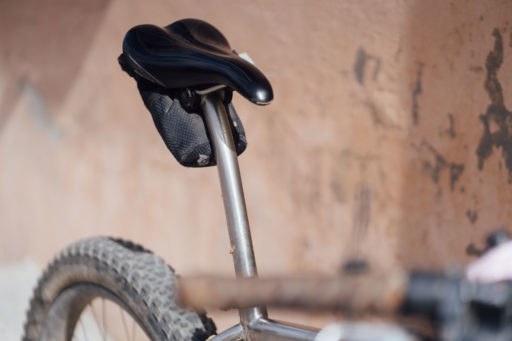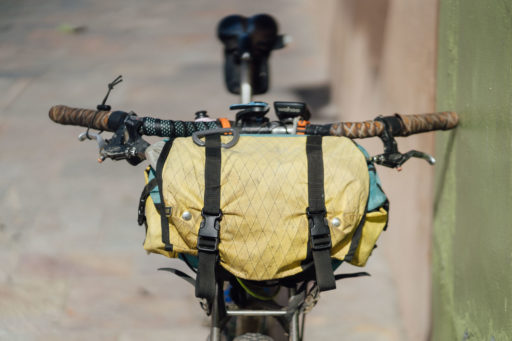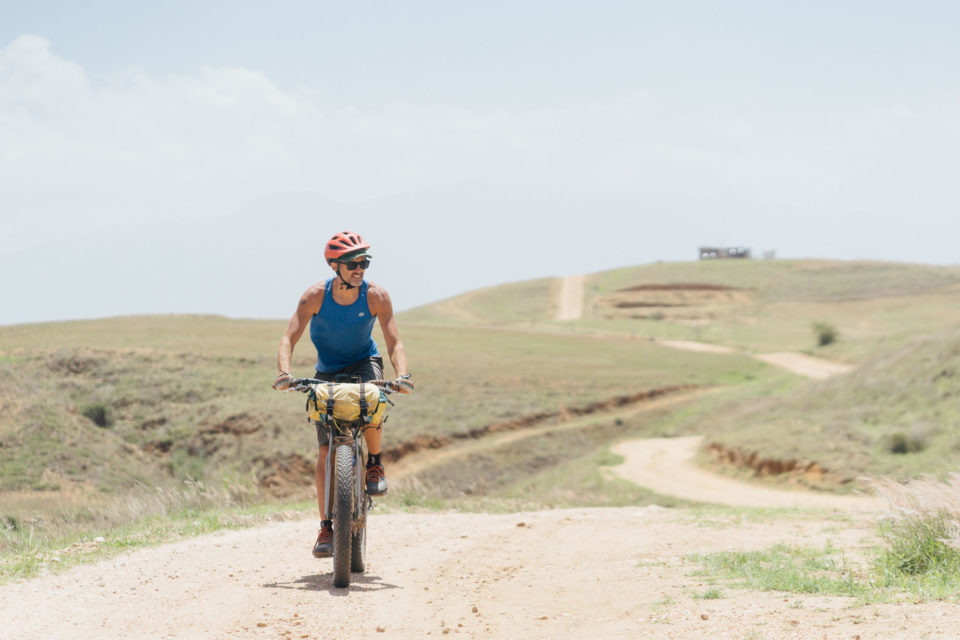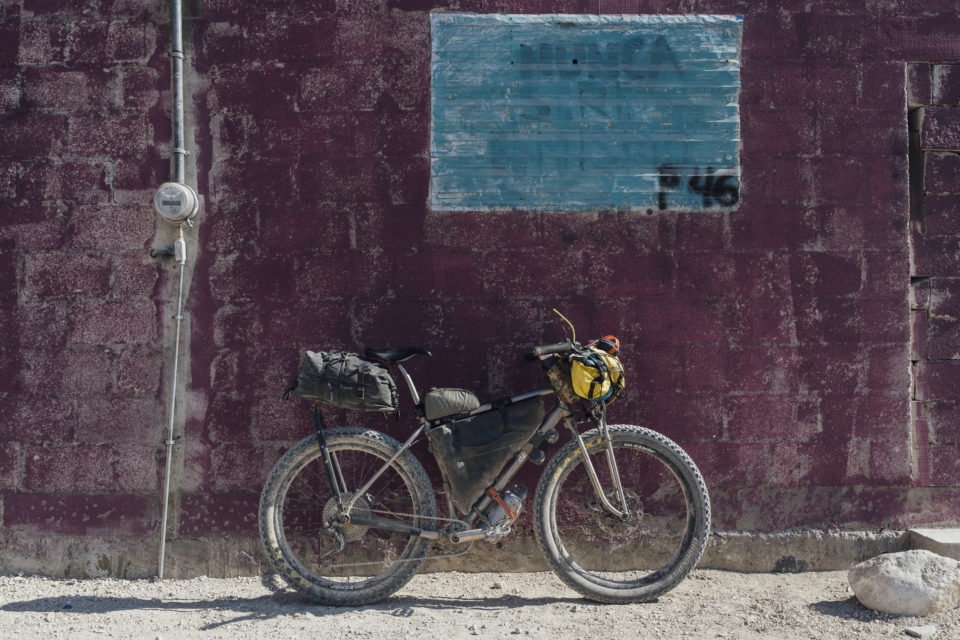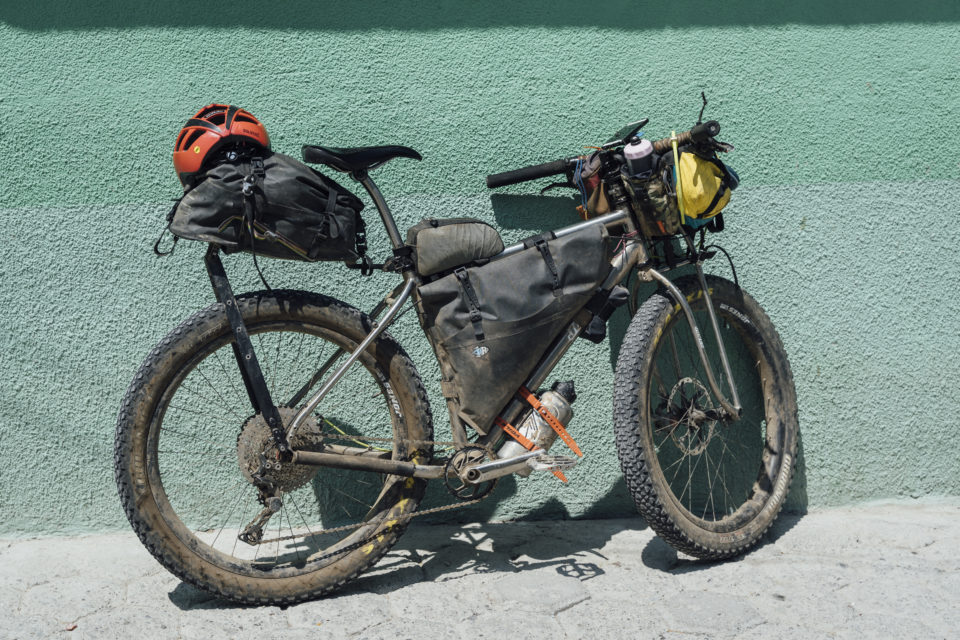Jones SWB Titanium Review: A Dream Bike and Dream Build
Share This
We take Jones’ premium, all titanium SWB—clad in a wardrobe of boutique parts—for an extended test ride. And we ask the question: if money is no object, can one frameset really provide a viable heart and soul for a bikepacking rig, a fast gravel machine, and a trail-worthy mountain bike? Read on to find out…
The Jones Pre-Amble
Amongst my personal bicycles, I own the original version of the Jones Plus LWB, which I purchased after reviewing it in 2016. It’s a joy to ride and it was my gateway into the Jones geometry that I’ve grown to love, largely because I find it both comfortable for long days in the saddle and extremely capable on trails.
Last year I spent a number of months riding the more affordable Jones SWB Complete, an $1,800 ‘short’ wheelbase, 27.5+ iteration of the Jones formula. I took it to home to Europe and rode it daily on forest roads with 2.8″ Schwalbe G-Ones Allrounds and on ‘proper’ trails with 3.0″ Nobby Nics and a dropper post. Fitted with G-Ones, it was the first time I genuinely saw this somewhat hefty bike’s potential for fast gravel riding. On my local trails with a dropper post, I felt like I was having just as much fun as my friends on hardtails with 130mm forks, even if I had to choose different lines and sometimes ride more slowly. Despite the entry level parts and price, I was very much taken by riding it.
At the end of the year, a fortuitous opportunity arose and I was sent the newly launched titanium version of the SWB, built up in a money-is-no-object ‘gravel’ form, fitted with an extremely lightweight truss fork, also made from corrosion-free and curvy space metal tubing. The geometry is identical to that of the SWB Complete, with the addition of an eccentric bottom bracket that offers 12mm of adjustment in BB height, opening up the potential for singlespeeding or running a Rohloff.
There are, in fact, two versions of the Titanium Plus SWB available: the more traditional Diamond frame and truss fork reviewed here (promising maximum framebag space and utility) and a curvy Spaceframe (which is designed to be more compliant). There are also full steel versions of these bikes too – the Custom Select range – which differ from the Jones Plus SWB and LWB Completes as they also have eccentric bottom brackets, truss forks, and customer-chose parts. And just to add to the gene pool, you can also chop and change materials. For example, a Jones Plus SWB Titanium Diamond frame and steel truss fork is $3,640 and a Jones Plus SWB Titanium Diamond frame with a butted steel unicrown fork is $3,340. Pictured below is an example of a steel Plus SWB with a matching steel truss fork ($1,350), set up as a singlespeed.

- Highlights
- Angles (LG): 69° Head tube, 72° Seat tube
- Chainstay: 449mm
- Bottom Bracket: 68mm BSA threaded
- Bottom drop: 76mm
- Hub specs: 15 x 150mm front / 12 x 148mm rear
- Seatpost Diameter: 27.2mm
- Max tire size: 27.5 x 3″ or 29 x 2.6″ tires
- Price (frameset): $4,250
But why the Jones life story? I introduce this review with an overview of my own experiences with the brand because I they’re a somewhat typical path for Jones customers. Namely, 1). Initial curiosity, 2). A reticence to overspend on an unconventional/untried system, and 3). A desire to save up for the titanium version!
Besides, Jones reviews are rarely straightforward, largely because these unconventional bikes aren’t the most simple of machines to dissect. This, combined with fact that I’ve been riding the Titanium SWB exclusively for 10 months now – driven by both a willingness to do so and my inability to return it during COVID-19 – means this write-up has taken on a more freeform shape than originally intended. Before digging in further, perhaps this is a good point to make a cup of tea!
How much?!
Make no bones about it, at $4,240, the Taiwanes-made, heat-treated, 3AL-2.5V version of the SWB is an extremely expensive frameset that may be considered by some to be a needless indulgence. It’s not an opinion that Jeff Jones would necessarily refute, either. When I asked him about the differences between the steel and the ti version, and who he sees the more expensive framesets appealing to, he was pretty matter of fact: most of the time, he recommends the steel version to his customers.
I’m not going to get into the argument around US versus Taiwanese titanium frameset pricing and quality. Even if the ‘penny welds’ aren’t on par aesthetically with a Californian-built Potts, suffice to say the finish on the SWB is extremely good, as you can see from the photoset at the very top of this post. I’m told by independent industry friends that Jeff Jones is renowned for demanding the very best materials and that his framesets are fabricated by the finest shop in Taiwan. Compared to a standard diamond frame and unicrown fork, there’s also no denying that a Jones Spaceframe and truss fork are considerably more time-consuming, and thus expensive, to make. The Why Cycles Chinese-made Wayword frame and US-made Oddity Squid fork is $3,449, by way of example, as reviewed here.
Still, whether you feel able to justify it or not, there’s no denying that this frameset is very spendy. Given that I was completely content with the bike’s more affordable steel rendition – and the entry level Plus SWB Complete at that – I was naturally intrigued by whether this significant upcharge would translate into a meaningful improvement into my enjoyment riding it.
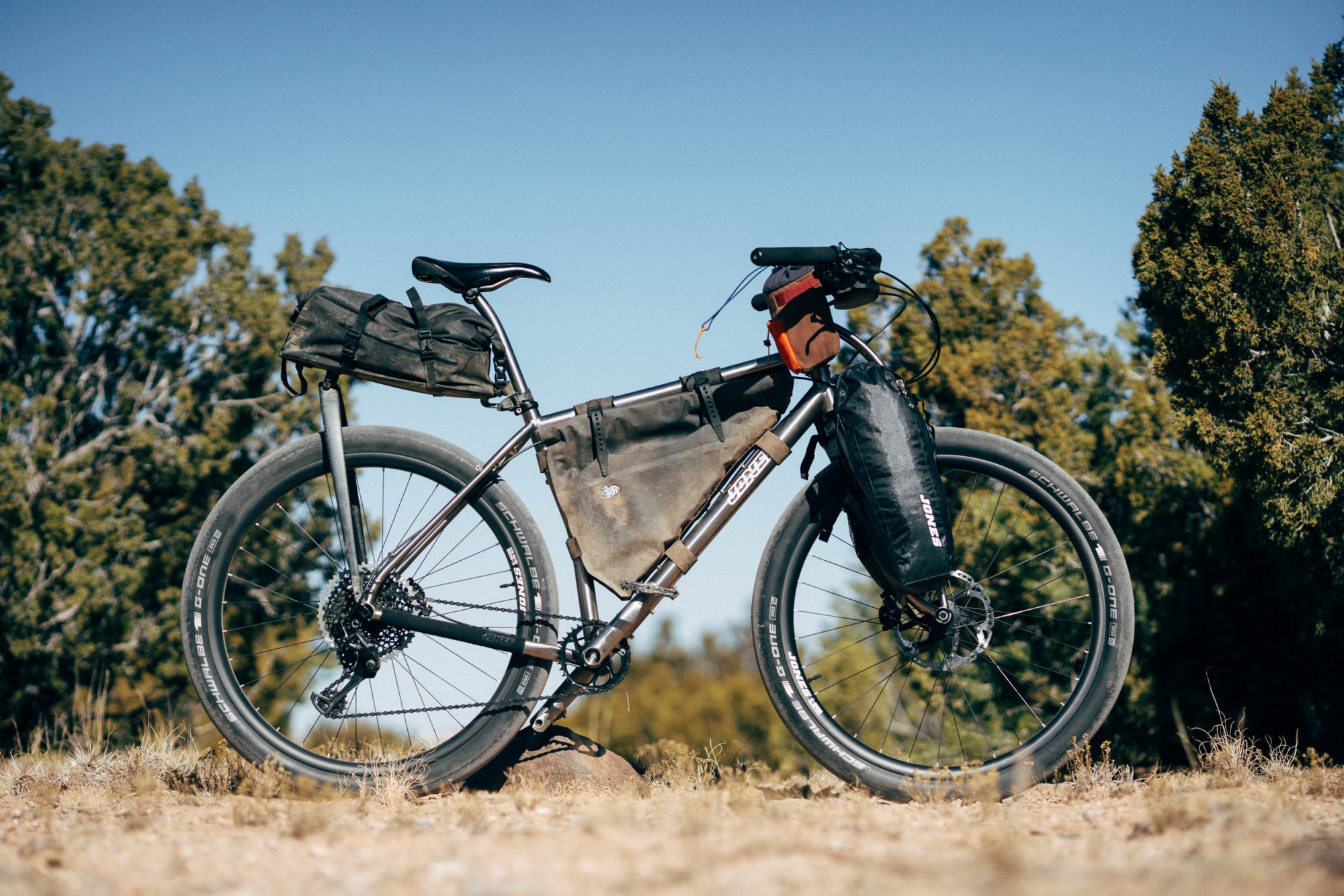
But here’s where a direct comparison gets a little complicated. A titanium frame merits a certain pedigree of components and the bike I was sent didn’t hold back. It included a $315 carbon H-Loop handlebar, Jones’ $599 29er C-Rims (with 2.35 G-One Speeds for gravel riding), an Eagle XX1 drivetrain, and to top it off, both a $280 ti Kent Eriksen Sweetpost, and $1,000 Ti Cane Creek eeWings cranks. In short, it was Jones’ vision of the ultimate gravel bike. The net result was a build that tipped the scales at a little over 24 pounds without pedals. For comparison’s sake, the SWB Complete weighs in at around 33.3lb.
It’s been a while since I’ve ridden anything this light – that wasn’t a road bike – so jumping onto the ti SWB was bound to be a thrill. I even giggled at the ease with which my seven-year-old son picked it up. In its gravel form, it’s lighter than the Bombtrack Hook EXT I reviewed last year. And whilst one can argue that you’d hope so, given its cost, let’s not forget that this is also a fully fledged mountain with 55m rims. It still has a couple pounds on the $7,500 Ti Bearclaw Beaux Jaxon Miles tested recently, but it’s similar to the Moots Baxter Logan rode, which has a frame-only price of $3,425. Throw on some 3″ tyres and I’m confident that it will outperform both of those bikes on technical trails.
Of course, I asked Jeff Jones why he chose to spec the bike with such an eyeball-rolling build – which totals a whopping $9,794 as listed below – and he said: “The bike I sent to you is a ‘Custom Select’ Jones bike, and they do not have a standard build. I built this one for me, to be the lightest and fastest road/gravel bike possible. For Custom Select bikes I help each customer pick the best parts for how and where they ride and for how much they want to spend so they get the best bike and ride. Many of my customers do go very high end with the titanium frames, but not always.”
As an example, the same frameset with a GX drivetrain, a Jones aluminium/DT wheelset, Vee Tire Bulldozers, an aluminium H-Bar-Loop, Avid BB7s, and Thomson finishing kit would come in at $6761. Although it’s on par with a carbon full susser, it’s also a completely different entity and likely to appeal to a different person – though I’ll bet any open-minded trail rider will be surprised by how capable the Jones can be.
Can one bike really do it all?
The perennial question, right? In my attempts to find out, you’ll see a number of different builds and wheelsets pictured here. For the first few months, I rode it exactly as it was sent to me, with a 29er C-Rim wheelset and 2.35″ G-One Speeds. Over the winter, it was my ‘gravel’ bike for fast day rides and weekend adventures. Commuting into town—a 10-mile round trip—had me riding hard out of the saddle, merely for the sheer joy of riding fast. Given that this is effectively a ‘plus’ bike, I had no idea it would be such fun.
Or so efficient, in fact. On windy days, I tucked my body forwards, placed my palms halfway up the handlebars, and hooked my thumbs into ‘loops’ of the H-bars, finding both speed and comfort in this position. With the mixed quality of paved and compacted dirt roads we have in Santa Fe, the SWB didn’t seem to give up much compared to a traditional drop-bar gravel bike, with the added bonus that it felt noticeably more capable when the terrain did roughen up, as it tends to do in New Mexico. I enjoyed how responsive the 500g G-One Speeds felt, though I did sense an element of self-steer when dirt morphed back to asphalt, unless I paused to air them up. Mated to Jones’ wide C-Rims – which measure 49mm internally and 56mm externally – makes for a surprisingly reasonable tyre profile, the tyre profile is surprisingly good—as you’ll see in the photos but still, I think I’d prefer a 40mm rim if I was running them permanently. In fact, for all-road riding I actually favour the now discontinued 27.5+ G-One Allround Liteskins (655g), because they have a deeper, more versatile tread pattern, and they’re better suited to wide rims. I’ve said this before, but I wish G-One Allrounds were available in a 29 x 2.6″ size! The G-Ones Speeds did surprise me, however, with how well they coped with sand when aired right down – the wide rim keeps them nice and stable too. And of course, you can run them at a much lower tyre pressure than you would with a more conventional gravel bike.
In the carousel below, you can see the bike as it was sent to me, set up for researching a gravel bikepacking route in Santa Fe. Scroll through for the variety of terrain I was riding.
As dirt roads turned increasingly muddy from snowmelt, I later fitted the SWB with Nobby Nic 29 x 2.6″ tires – adding an extra 900g of rotational weight. Despite their less efficient tread pattern for road riding, they immediately felt more suitable to New Mexico’s mixed terrain. With these very capable 29 x 2.6s, I enjoyed day trips with friends and overnighters in Northern New Mexico and neighbouring Texas. Whilst the frame has excellent mud clearance with 27.5 x 3in tyres, 29 x 2.6s allow considerably more space between the chain was in the last sprocket of the cassette, which is a boon when things get really muddy, as they often do in New Mexico.
In February, I crossed the border into Mexico, choosing to run a 27.5+ C-Rim wheelset with Maxxis Chronicles, which felt appropriate to the 800-mile segment of the Baja Divide I’d be riding. I had no complaints there at all: I loaded the bike up and occasionally carried 12 litres of water over rough and sandy surfaces. As a sidenote, I should mention that I wouldn’t normally choose to travel overseas with such a costly bike. Whilst I don’t believe Ti draws any more attention than steel, the consequences are far greater should anything happen, and that goes for dinging the frame as much as theft. But the temptation to keep riding it was too great!
Before I rode south, however, I swapped the Eagle XX1 drivetrain for a more humble Shimano 11-speed setup, mated to a longer-lasting 11-50T Sunrace cassette, which I did in part because I figured replacements would be more readily available and affordable in Mexico, and the SLX shifter and XT rear mech I already owned have proved tough and reliable. As it is, I now know that 12-speed SRAM parts of all grades appear to be relatively common in Mexico’s high-end bike shops and the prices are generally in line with the US, so I probably needn’t have worried so much. I also fitted a set of mechanical Avid BB7s I already owned in lieu of hydraulic XTs in the interest of simplicity and reliability. I was tempted to swap out Cane Creek’s eeWings but I ended up leaving them on, as I didn’t have the tool to remove them. Thankfully, eight months later and they’ve remained faultless as well as gorgeous. Does their performance or looks justify their price? Probably not! But at least they’ve proved to be very dependable.
Price aside, I had no qualms keep the SWB’s lightweight C-Rim/DT hub wheelset on the bike for such a trip, as they’ve already proved themselves to me – the rear rim is offset for a near dishless build and their walls are reassuringly thick. I’ll admit that from being a carbon wheel neigh sayer, the C-rims have turned me into a convert. As a minor build detail, I love the addition of Paul’s Quick Release Seat Post Collar. It’s one of the few quick-release models that clamp tight enough to ensure that the seat doesn’t slip, and has made technical day rides a lot more enjoyable in the absence of a dropper post.
Jones SWB vs. LWB (29+ vs 29 vs 27.5+)
What’s the difference between the Plus LWB (29+) and the Plus SWB (27.5+)? Although discussed in the SWB Complete review, here’s my take in a nutshell. Contrary to popular expectations, the LWB is a very quick handling bike that excels on technical trails and I actually find it superior as a mountain bike, especially over rocky and slabby terrain. Its 29+ tyres, extra fork offset (76mm compared to 55m on the SWB) add confidence on steep and technical terrain, as there’s little chance of going over the handlebars. I believe it’s truer to Jones’ design vision of what the ultimate rigid mountain bike should be.
However, I prefer the inherent versatility of the SWB. For instance, its bottom bracket height remains similar between the 27.5+ and 29 x 2.3″ wheel formats, which makes it extremely versatile – it’s fun as a mountain bike and very capable as gravel bike. Its front end can be more easily lofted and it’s a little lighter. In terms of travelling, it’s easier to pack or a bike bag in a box on a trip overseas. There’s better tyre availability around the world, too, whilst 29+ remains very much US-centric.
The riding position between the Plus SWB and LWB is very similar. However, to achieve this the SWB uses a laid back seat post, whilst the LWB’s recommended post is inline. This impacts framebag size (the LWB is larger, noticeably) and means the LWB actually lends itself better to a dropper post (not that it’s stopped me from using one on the SWB). In terms of sizing, I should add that at 6’1”, Jeff Jones recommended a Medium frame to me in both bikes. I chose a Large and I’m very happy with it. However, if I was to experiment, I’d consider sizing down to a Medium on the LWB.
As for running the SWB with a 29 x 2.5/2.6″ setup, I see advantages and disadvantages. Remembering that this is a fully rigid bike with no active suspension, 27.5+ feels markedly more comfortable over rough stuff. Like its 29+ sibling, plus tyres can bulldoze through most terrain and are better at low pressures in soft sand, like that found on the Baja Divide.
However, I found myself surprised by how much I enjoyed riding the SWB with a 29 x 2.6″ wheelset. In this mode, the SWB feels more taut and precise. It’s quicker to pick up to speed, even if tyre weight is largely similar (Schwalbe’s Nobby Nic is 1010g in 27.5 x 3″ and 950g in 29 x 2.6″). It feels less sensitive to nailing optimal tyres pressures, too. And whilst the overall riding experience isn’t as plush, the larger wheel diameter rolls really over rocks and being markedly taller, decreases the chance of pedal strike. Perhaps of most importance for those who live in wet and muddy parts of the world, the ‘skinnier’ tyre has less of a tendency to plane over mud and there’s better chain to tyre clearance too, which means you’re much less likely to collect and track mud into the drivetrain. As an added bonus, it’s more likely to fit in public transportation bike racks.
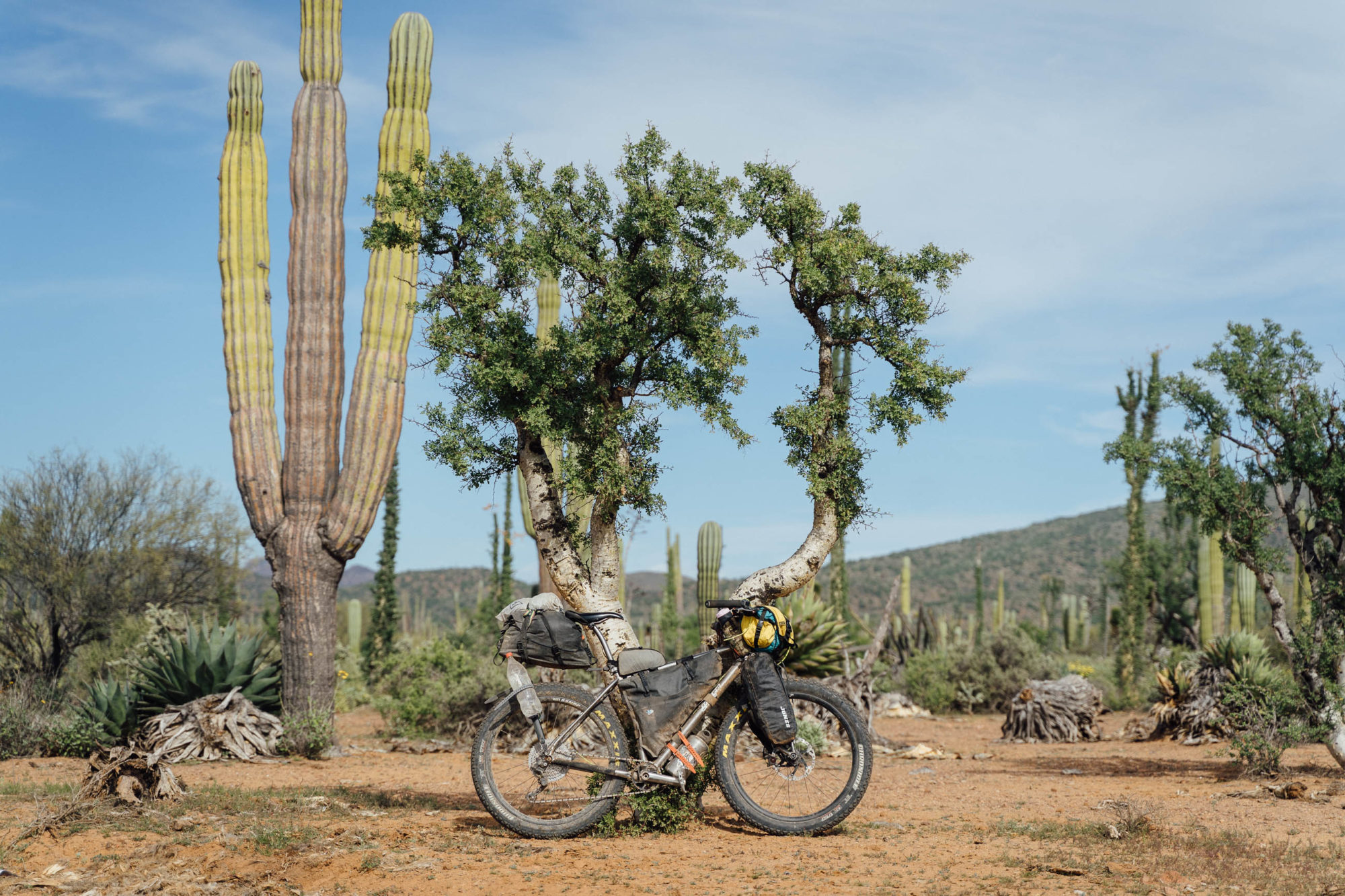
More recently and during Covid-19, most of my riding has been unladen. During this time, the SWB has proved itself an ideal steed for both day rides on rural terracerías here in Oaxaca—which are a mixed bag in terms of surfaces- along with blue and occasionally black-graded steep and rutted singletrack, as seen on Trailforks. Being such a light bike, I can’t deny that I haven’t thoroughly enjoyed how it rides bereft of camping gear!
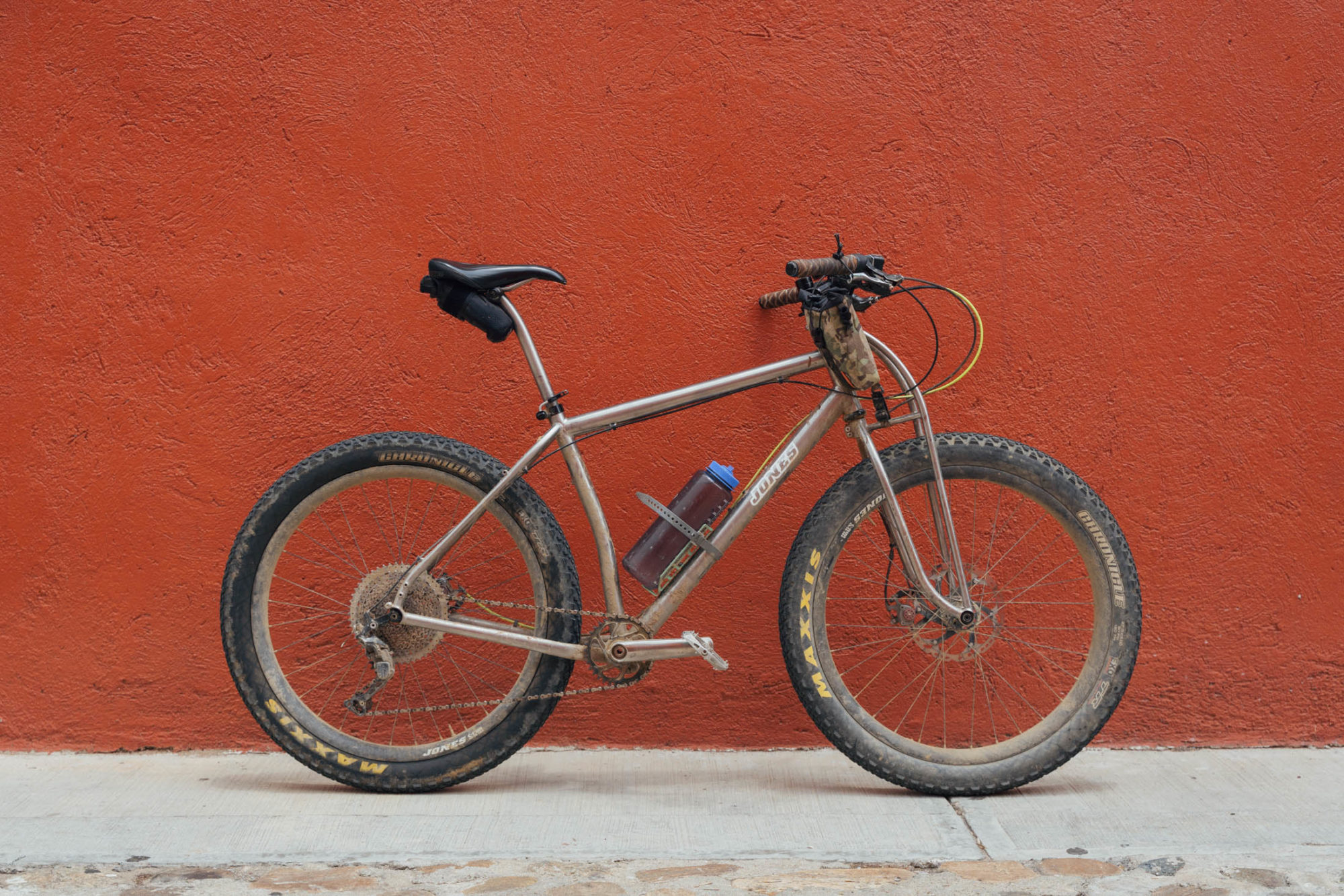
Geometry:
All sizes of the Jones SWB have a 69° head tube angle and a 72° effective seat tube angle. The chainstays are 17.68″ (449mm) from bb to axle center and the fork offset is 55mm, which is greater than normal but less than the slacker LWB (67.5 HA, 76mm offset). Here are the wheelbases for the three sizes:
Small: 41.9″ (1066mm)
Medium: 42.98″ (1091.72mm)
Large: 44.05″ (1118.95mm)
The SWB is also rigid specific, so you’ll either need to run it with a ti or steel Truss fork, or Jones’ unicrown alternative, which has the same axle to crown length and fork offset. It’s heavier but more utilitarian – complete with cargo cage eyelets and low rider mounts.
Amongst other differences to many modern mountain bikes, the Jones geometry is known for its relatively short reach and high stack, giving a more upright riding position than most people are used to. A full geometry chart isn’t available, maybe due to numbers that are likely to be off-putting to some – especially if the bikes are studied rather than ridden. Instead, there are three height recommendations for the three sizes available, with accompanying standover clearances. If in doubt, give Jones a ring to discuss the finer details. As mentioned, Jeff Jones pointed me towards the Medium as I’m between both sizes. I opted for the Large and I’m glad I did, although I admit that I’m curious to know what the Medium would have felt like, and whether it would have worked for me. My height and inseam can be found at the bottom of this review.
SWB Spaceframe sizing:
Small: Rider height 5′ – 5’8″ (152cm-174cm), Standover at center of top tube is 26.5″ (67.3cm)
Medium: Rider height 5’6″ – 6’2″, (171cm-188cm) Standover at center of top tube is 27″ (68.6cm)
Large: Rider height 6′ – 6’6″, (183cm-198cm) Standover at center of top tube is 28″ (71.2cm)
SWB Diamond frame sizing:
Medium: Rider height 5’8″–6’2″ (174cm-188cm). Standover at center of top tube is 30.5″ (77.5cm).
Large: Rider height 6′–6’5″ (183cm-202cm). Standover at center of top tube is 32″ (81cm).
Need some more numbers? Use Bike Insights to make comparisons between the Jones SWB – trail, reach, stack etc – and other bikes you may be more familiar with.
SWB frame and fork weights:
Titanium Plus SWB Spaceframe: Small 2295g, Medium 2400g, Large 2455
Titanium Plus SWB Diamond frame: Medium 2232g, Large 2335g
Titanium Truss Fork: Small 1020 g, Medium 1025g, Large 1043g
Steel Truss fork: Medium 1345g
Steel Unicrown fork: (one size) 1436g
Jones didn’t have a full list of steel frames to hand. But a ti Diamond frame is around 630g lighter than a steel Diamond frame and a ti Spacefame is around 700g lighter than a steel Spaceframe. This means the overall difference between the framesets will be 900-1000g, depending on the frame style and the size.
Further to the box out above, eagle-eyed readers will notice this bike isn’t available in a size small as a Diamond frame. Shorter riders are limited to the Spaceframe (as shown below), which carried a $300 upcharge and a small weight penalty. Like the Diamond frame, it includes a number of rack mounts for running small panniers, which is useful if the clearance between your seat and the rear tyre is too limited for a standard seat pack, though the Truss Fork Packs can expand capacity significantly. Whilst the size of framepack is more limited on a Spaceframe, it actually works out to be the same volume to a similarly sized hardtail, as the frame isn’t suspension-corrected.
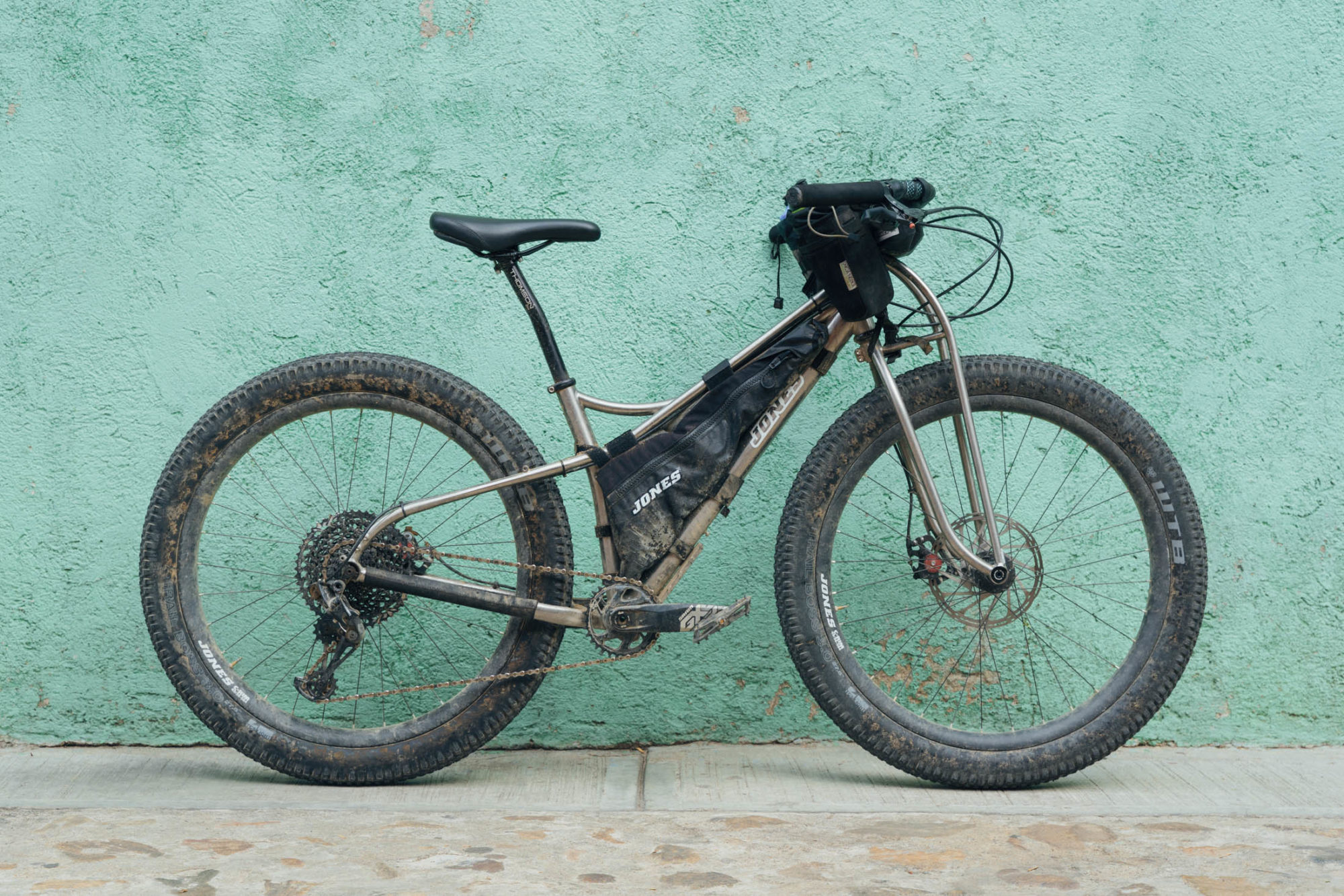
The Ride
I deep-dived into how the SWB Complete handled and in all honesty, when you’re in the thick of the moment, this bike doesn’t feel all that different. It’s a good reminder of the importance of geometry as much as a choice in frame material. It is a good deal lighter though, which makes it markedly more enjoyable to climb on, especially unladen. Perhaps less important but still of value, it also makes it more pleasant to shoulder the bike up a flight of stairs. With a titanium frameset at its core and a choice of minimal bikepacking bags, the potential exists to run a liver lightweight rig.
Having tried all of Jones’ different handlebars, it’s clear that the carbon version of the H-Bar Loop adds noticeably to front end comfort. More important, though, is figuring out the right tyre pressure—12-15psi felt about right to me, though I found myself creeping ever lower. Why the obsession with tyres pressures? The SWB is rigid specific, which means there’s no option to fit a suspension fork. And despite the slender titanium tubes, Jeff Jones actually points out that a triangulated truss fork can feel harsher than the unicrown version over some terrain – like corrugated roads – as there is effectively no fore and aft chatter. Combined with a 150mm TA hub, it does, however, makes for super-precise steering that comes into its own on technical terrain, with no flex under braking.
As for rear end comfort, this SWB has an extra trick up its sleeve. Although keeping to a more traditional 27.2mm diameter seat post limits options for modern droppers, it does make for a more forgivig ride, especially when the seatpost is made from titanium!
A relatively low bottom bracket gives a nice ‘in the bike feeling’, whilst the recommended 170mm crankset (which is 5mm shorter than you’d expect) goes some ways towards improving ground clearance. But compared to the SWB Complete, I was grateful to have an eccentric bottom, which caters for different cycling styles and wheelsets. For example, much of my riding here includes technical singletrack, so I’ve adjusted it to the uppermost position. This is 12mm higher than the way I ran it on the Baja Divide and makes a significant difference to pedal strikes, especially as I favour broad platform pedals, rather than lower-profile clipless ones. If I was spending most of my time gravel riding, I’d probably lower it back down again, or settle on a mid point.
Jones bikes are noted for their unconventional geometry, and this stands out all the more next to current industry trends. Most notably, the extra fork offset serves to lower the SWB’s trail figure and sharpen handling, while a relatively long wheelbase (despite the name) helps maintain a sense of stability on descents. It also makes this bike a surprisingly proficient climber on technical terrain. There’s plenty of room to move around the cockpit without losing traction at the back, or needing to force your chin down to the handlebars to avoid the front end popping up.
Like all Jones bikes, the SWB is designed in tandem with Jones’ iconic H-Bars, which sport a distinctive 45-degree sweep, as well as extra-long grips. The idea here is to use the full length of the bar, rather than restricting yourself to a single hand position. Scoot right back on descents for a confidence booster over technical terrain. Hold on to the middle of the grips for day-to-day riding. And slide forwards when climbing, to place more weight over the front of the bike. This forward position also serves to lengthen your back and place the body in more of an aero tuck on a windy day, without the compromise in lower back comfort that results from being stooped in a drop handlebar – particularly over long periods of time. In fact, whilst the multitude of hand positions is often cited as a reason for running drop handlebars, I’d suggest there are just as many options on an H-Bar – especially when you factor in the bike’s short top tube, which puts you in a better place to use them all. It’s here that the bike differentiates itself from fitting a different handlebar to a more conventionally designed rigid mountain bike. The SWB’s geometry is as much about a rethink in body position as it is about adaptive handling.
Niggles? There are a few, even with a bike of this price! Unfortunately, there are no water bottle mounts on the seat tube and the positioning on the downtube means it will work with some cages better than others. King Cage Ti Many Thing Cages didn’t fit on my pre-production test bike, though from what I understand, the final version has slightly different eyelet placement.
As mentioned, my bike came with a ‘gravel’ build that included 38T chainring and a 10-50T Eagle cassette. The intention here was to ensure the gearing didn’t top out too quickly on all-road rides. Whilst this has largely been the case, it’s not a trade-off I’d make again, as it translates into too large a gear inch for mountain touring.
In terms of luggage, Jones sells a number of Ortlieb and Revelate bags, including custom-made frame bags. I’m not, however, a big fan of the slender Sweetroll handlebar bag. Although it fits securely on H-Bar Loop bars and lends itself well to the shape of the truss fork, it’s awkward to pack. Note too that the truss fork and H-Bar loop don’t play well with large, top-access handlebar bags – the style of bag I much prefer. I found a BXB Goldback Medium to be about ideal, though I had to swap the H-Bar Loops for the H-bar Bend to be able to open the lid more easily. If you have to box the bike, wide ones are best due to the 150mm TA spacing on the fork and note that it’s a lot more fiddly to take out and set up again than a standard unicrown fork.
The upside of the Ti truss, apart from saving a few hundred grams of weight, is that you can get use Jones’ excellent Revelate-made Truss Fork Packs, which I reviewed here. These bags will really suit smaller riders who aren’t able to run a large seatpack. And, if you don’t want to invest in them, I’ve noticed that 1.5L Nalgene bottles fit well, held in place with a Voile strap—good for desert rides like the Baja Divide. Otherwise, Jones offers adaptor clamps to run water bottle cages and cargo cages.
Given the frameset’s versatility, it’s well worth investing in two wheelsets to get the most out of this bike. Just remember that the front wheel uses a 150mm thru-axle hub, like a fat bike. Although this spacing makes for a very strong, dishless wheel, especially when built up with C-Rims, it also rules out off-the-shelf wheelsets. And whilst there are a few 150mm TA dynamo hubs on the market, expect them to be more expensive, and should it fail on tour, a replacement front hub will be that much harder to source.
Build Kit
- FRAME Jones Titanium Diamond Plus SWB pre-production (L)
- FORK Jones Titanium Truss fork for Plus SWB pre-production
- SEAT COLLAR DKG Bolt Type
- HEADSET Jones sealed cartridge bearing H-Set for Truss fork
- STEM Thomson Elite X4. 60mm x 10°
- HANDLEBAR Jones Carbon Loop H-Bar 710mm
- GRIPS Jones EVA H-Grips for 710mm H-Bars
- BRAKES Shimano XT M8000 Hydraulic with 180/200mm XT Icetec discs
- SHIFTER SRAM XX1 Eagle
- REAR DERAILLEUR SRAM XX1 Eagle
- CRANKS & CHAINRINGS Cane Creek Titanium eeWings 170mm + SRAM 38 t X-sync
- BOTTOM BRACKET Wheels Manufacturing Black
- CASSETTE XX1 10-50t Black
- CHAIN XX1 Eagle 12 Speed
- FRONT HUB DT Swiss 350 Big Ride
- REAR HUB DT Swiss 350, Boost, 6-Bolt, XD Driver
- SPOKES DT-Swiss Competition Black spokes and DT-Swiss Silver Alloy nipples
- RIMS Jones C-Rim 29 (Off-Center drilling at back)
- TIRES Schwalbe G-One Speed TL Easy 29×2.35″
- SEATPOST Kent Eriksen “Sweetpost’
- SADDLE WTB Pure
- WATER BOTTLE MOUNTS 2 inside frame on downtube, cargo cage mounts on downtube
- RACK MOUNTS Rack mounts at dropout (3 options) and seat stays
- EXTRAS Eccentric bottom bracket (12mm adjustability)
Pros
- Jones geometry is extremely comfortable, on and off road.
- The SWB is a fun and capable trail bike too. Don’t let looks and lack of suspension deceive you!
- Great climbing prowess thanks to fork offset, Jones bars, and wheelbase.
- Versatile frame that can do almost anything with a change of wheels and tyres.
- Truss fork is very light and precise, while the optional Truss Pack is great for extra capacity.
- Superb wheelset that includes offset drilling and wide hubs for the ultimate in strength to weight.
- Ti too pricey? Choose steel! Lots of build options to suit your budget.
- This is a Bike For Life as long as parts remain available.
Cons
- Plus tyres aren’t a match for a plush 130mm suspension fork. Expect to make different line choices.
- Expensive frameset, though there are mix and match steel options available too.
- Truss fork and H-Bar Loops limit options for handlebar bags.
- Truss fork is also fiddly to remove if you need to pack the bike into a bag.
- Jones’ 49/55mm C-Rims are more suited to wider tyres than 2.35s.
- 150mm TA front hub spacing means you’ll need to go custom for a second wheelset.
- 3″ tyres and 1x drivetrains can create issues in muddy conditions.

- Size Tested L
- Sizes Available M & L (S available as a Spaceframe)
- Weight (as tested) 10.88kg (24lb)
- Price $4,240 (ti Diamond frameset + ti Truss fork)
- Contact Jones Bikes
- Recommended Uses Bikepacking, trail riding, gravel riding, touring
Wrap Up
In case it’s not obvious, I’ve loved riding this bike! In its dream build with fast-rolling tyres, it’s no slouch on gravel day rides. Swapped out for knobblies and with the addition of a dropper post, the SWB morphs into a fun mountain bike for everything but the most demanding trails (depending on the pilot, of course). Load it up with bikepacking bags, and you can expect to enjoy a comfortable riding position that’s extremely conducive to long hours in the saddle.
But that leads us to the big question. Is the titanium version of the SWB bike worth the massive upcharge over the steel one? There’s no doubt that the bike, in the form it was sent to me, is as close to a ‘quiver killer’ as I’ve ever tried. But I also have to concede that the gains in its frame alone are marginal – we’re talking nuances and in all likelihood, an emotional response to titanium. Ultimately, it’s simply not going to make or break your riding experience compared to its steel doppelgänger.
In fact, if you’re going to invest in a titanium SWB – or an LWB, for that matter – I’d be inclined to nudge you towards the Spaceframe, unless its primary use is as a bikepacking bike. Despite all the extra tube bending, the Spaceframe is only a few hundred dollars more and more likely to make a meaningful difference to the ride.
I referenced the idea of a bike’s soul in this review’s excerpt, because whilst it’s easy to see how a number of steeds can be used for a multitude of disciplines, it doesn’t necessarily mean they’re going to leave us genuinely satisfied. I believe that the SWB is one of the few bikes that can actually live up to this elusive ideal. My reasoning is simple. When I’m riding this bike, whether on gravel, trails, or touring, I rarely wish I was aboard anything else.
So yes, if money is no object and parting ways with a briefcase of cash won’t impact the rest of your life, then go for it! Even if the law of diminishing returns applies, it’s still the ultimate conclusion of a superb bike. Otherwise, rest assured you’ll be almost as happy with the steel version, a considered build, and a set of lightweight wheels. Either way, I have no doubt that the SWB will bring you joy wherever you choose to ride it, for years to come.
Rider’s Background
I’ve been embarking regularly on two-wheeled explorations for over twenty years. I’ve crossed the Republic of Georgia on dirt roads, tackled the Colorado Trail, ridden the UK’s Lakeland 200, and followed the Trans Alps in Europe. Given my love for mountain biking and backcountry touring, my ideal journey fuses the two, keeping to quiet dirt roads and singletrack where possible.
Height: 6’05” (184.5cm)
Weight: 165 lbs (75kg)
Inseam (PBH): 91.4cm
Please keep the conversation civil, constructive, and inclusive, or your comment will be removed.






